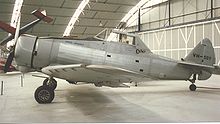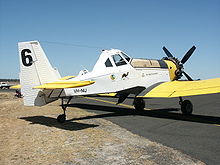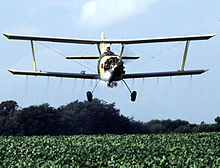- Agricultural aircraft
-
 The Antonov An-2 was the first purpose-built agricultural aircraft to be mass-produced.
The Antonov An-2 was the first purpose-built agricultural aircraft to be mass-produced.
An agricultural aircraft is an aircraft that has been built or converted for agricultural use - usually aerial application of pesticides (crop dusting) or fertilizer (aerial topdressing); in these roles they are referred to as "crop dusters" or "top dressers". Agricultural aircraft are also used for hydroseeding.
The most common agricultural aircraft are fixed-wing, such as the Air Tractor, Cessna Ag-wagon, Gippsland GA200, Grumman Ag Cat, M-18 Dromader, PAC Fletcher, Piper PA-36 Pawnee Brave and Rockwell Thrush Commander but helicopters are also used.
Contents
Early use of aircraft in agriculture
Crop dusting with insecticides began in the 1920s in the United States. The first widely used agricultural aircraft were converted war-surplus biplanes, such as the De Havilland Tiger Moth and Stearman. After more effective insecticides and fungicides were developed in the 1940s, and aerial topdressing was developed by government research in New Zealand, purpose-built agricultural fixed-wing aircraft became common.
Agricultural aircraft designs
In the US and Europe they are typically small, simple, and rugged. Many have spraying systems built into their wings, and pumps are usually driven by wind turbines. In places where farms are larger, such as New Zealand, Australia, the former Warsaw pact nations and parts of the developing world, larger and more powerful aircraft have been used, including turboprop powered aircraft such as the PAC Cresco, twin engined types, such as the Lockheed Lodestar and varying from the versatile and utilitarian Antonov An-2 biplane to the bizarre turbofan powered biplane, the WSK-Mielec M-15 Belphegor- all however tend to be of simple rugged STOL design. In places where dedicated use as an agricultural aircraft is uneconomic, utility types such as the De Havilland Canada DHC-2 Beaver have been used.
In the case of helicopters, tanks are placed on or outside the body of the aircraft, while a spray rig, extending outward to the sides, is attached well below the main rotor blades. Hydroseeding is often done by helicopters using tanks and drop systems much like those used for aerial firefighting.
Techniques
To reduce drift of the sprayed materials, agricultural pilots attempt to fly as low as possible, usually just above the crops being treated (4.5 meters/15 feet). Fields are often surrounded by obstacles such as trees, telephone lines, and farm buildings, so pilots have to switch quickly from the task of dropping chemicals accurately and smoothly to the task of dodging obstacles. It is not unusual for pilots to fly under telephone and power lines at the end of their runs. Nonetheless, accidents are inevitable when airplanes routinely fly so near the ground. Purpose-built agricultural airplanes are designed to protect the pilot and cargo if they strike the ground.
Conflicting views on aerial spraying
 Australian Commonwealth CA-28 Ceres crop spraying aircraft of the 1950s
Australian Commonwealth CA-28 Ceres crop spraying aircraft of the 1950s
Aerial spraying has been controversial since the 1960s, due to environmental concerns about pesticide drift (raised for example by Rachel Carson's book Silent Spring). It is now often subject to restrictions, for example spraying pesticide is generally banned in Sweden, although exceptions can be made such as for an area plagued by mosquitoes during summer. Even the spread of fertilizer has raised concerns, for example in New Zealand fertilizer entering streams has been found to disproportionately promoted growth of species more able to exploit the increased nutrients, so leading to restrictions on topdressing near waterways. Even putting out forest fires has been criticized in the U.S.A. as preventing natural consumption of flammable material, and increasing long term risk.
See also
- Aerial topdressing
- Aerial firefighting
- Aerial application
- Pesticide drift
- Notable cropduster pilots
- Manufacturers
External links
- Farming Takes to the Air September 1940 Popular Mechanics
Lists relating to aviation General Aircraft (manufacturers) · Aircraft engines (manufacturers) · Airlines (defunct) · Airports · Civil authorities · Museums · Registration prefixes · Rotorcraft (manufacturers) · TimelineMilitary Accidents/incidents Records Categories:
Wikimedia Foundation. 2010.


